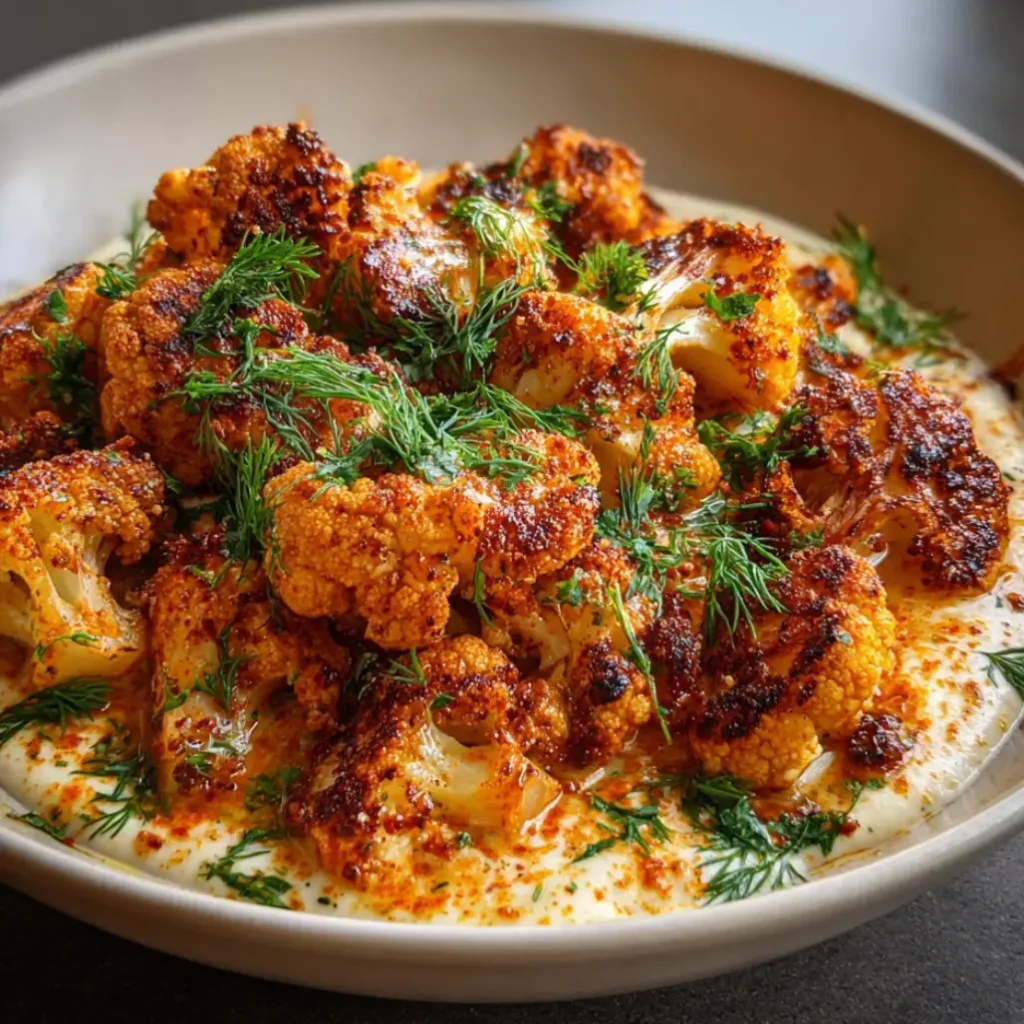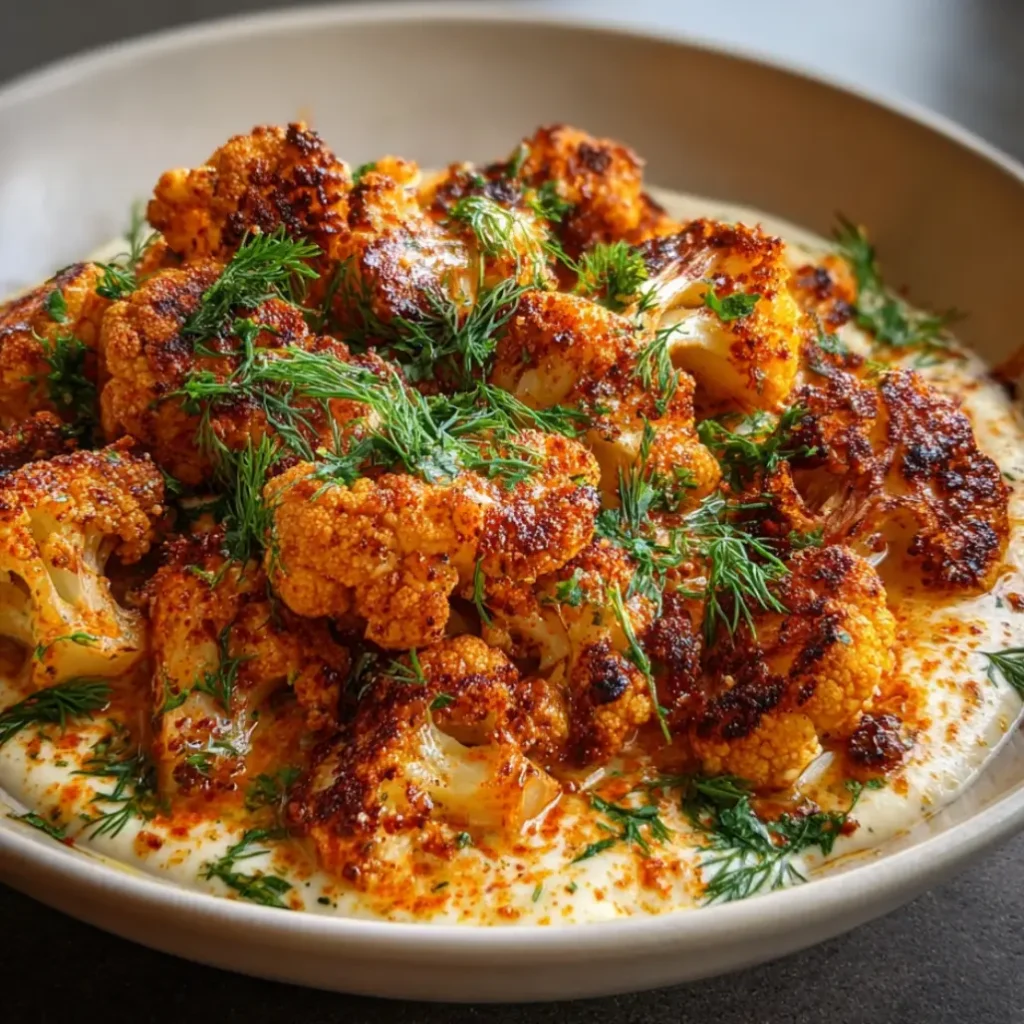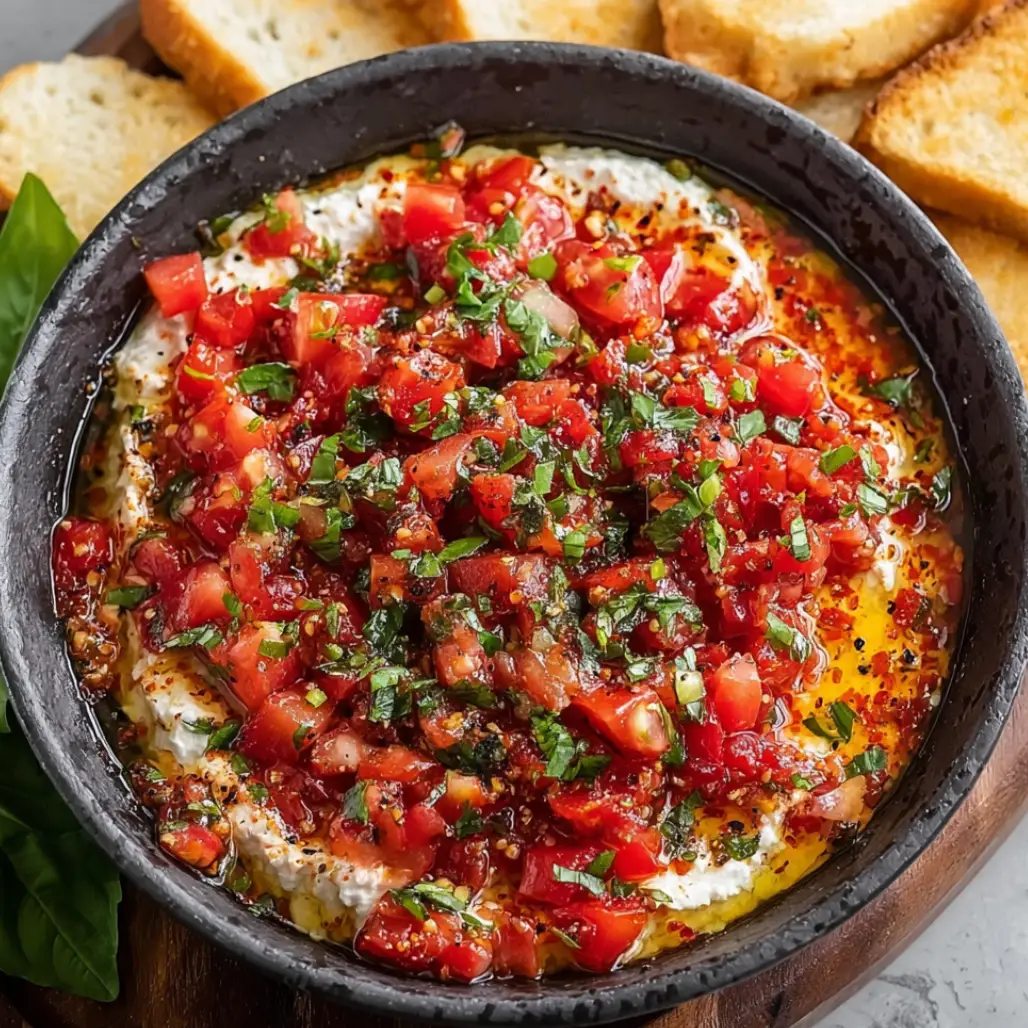| Prep Time: | 15 minutes |
|---|---|
| Cook Time: | 35 minutes |
| Total Time: | 50 minutes |
| Serves: | 4 |
Envision this stunning harissa cauliflower tahini dill creation emerging from your oven with perfectly charred edges and an aromatic blend of Middle Eastern spices because this extraordinary recipe transforms humble cauliflower into a restaurant-quality masterpiece that balances fiery harissa heat with cooling tahini creaminess. This remarkable harissa cauliflower tahini dill dish delivers complex flavor layers because it combines the smoky intensity of North African harissa paste with the nutty richness of tahini and the bright freshness of dill, creating an unforgettable culinary experience that satisfies both comfort food cravings and sophisticated palates.
Why Harissa Cauliflower Tahini Dill Creates Pure Magic
This incredible harissa cauliflower tahini dill recipe succeeds brilliantly because it achieves the perfect balance between bold, aggressive flavors and soothing, cooling elements that complement each other beautifully without overwhelming the palate. The harissa paste provides smoky heat and complex spice notes because it contains carefully blended chilies, garlic, and aromatic spices that have been concentrated into an intensely flavorful paste that coats each cauliflower floret.
The genius of this harissa cauliflower tahini dill combination lies in its textural contrast because the crispy, caramelized cauliflower exterior gives way to tender, fluffy interiors while the creamy tahini sauce provides luxurious smoothness that mellows the harissa intensity. Fresh dill adds herbaceous brightness because its feathery leaves contribute cooling notes and visual appeal that balance the earthier flavors beautifully.
This preparation method proves remarkably versatile because the harissa cauliflower tahini dill works equally well as an impressive side dish for elegant dinner parties or as a satisfying vegetarian main course that provides substantial nutrition and complex flavors. The roasting technique develops deep, caramelized flavors because high heat creates Maillard reactions that intensify the natural sweetness of cauliflower while adding smoky complexity.
Essential Ingredients for Perfect Harissa Cauliflower Tahini Dill
For the Roasted Cauliflower:
- 1 large head cauliflower (about 2 pounds), cut into 2-inch florets
- 3 tablespoons extra virgin olive oil
- 2 tablespoons harissa paste (adjust to taste preference)
- 1 teaspoon kosher salt
- 1/2 teaspoon freshly ground black pepper
- 2 cloves garlic, minced
For the Tahini Dill Sauce:
- 1/3 cup tahini paste, well-stirred
- 3 tablespoons fresh lemon juice
- 2 tablespoons warm water (more as needed)
- 1 tablespoon pure maple syrup or honey
- 2 tablespoons fresh dill, finely chopped
- 1/2 teaspoon salt
- 1/4 teaspoon ground white pepper
For Garnish and Enhancement:
- 1/4 cup Medjool dates, pitted and chopped
- 1/3 cup toasted pistachios, roughly chopped
- 2 tablespoons fresh dill sprigs for finishing
- 1 tablespoon sesame seeds
- Lemon wedges for serving
The Art of Creating Harissa Cauliflower Tahini Dill
Mastering this spectacular harissa cauliflower tahini dill requires understanding the delicate interplay between high-heat roasting and sauce preparation because successful execution depends on timing, temperature control, and proper seasoning balance throughout the cooking process. The cauliflower must achieve perfect caramelization because this develops the deep, complex flavors that serve as the foundation for the entire dish.
The tahini sauce preparation proves equally crucial because proper consistency and flavor balance ensure that it complements rather than competes with the intensely flavored cauliflower. The sauce should coat beautifully without being too thick or thin because the right consistency allows it to cling to each floret while providing creamy contrast to the crispy exterior textures.
Temperature management becomes critical during roasting because cauliflower requires high heat to develop proper browning while avoiding burning the delicate harissa paste coating. Understanding visual and aromatic cues helps determine doneness because properly roasted harissa cauliflower tahini dill should be golden brown with slightly charred edges and fork-tender throughout.
Step-by-Step Instructions for Harissa Cauliflower Tahini Dill
Step 1: Prepare the Cauliflower Foundation
Preheat your oven to 425°F and line a large rimmed baking sheet with parchment paper because this prevents sticking while promoting even browning across all florets. Cut the cauliflower into uniform 2-inch pieces because consistent sizing ensures even cooking and prevents some pieces from burning while others remain undercooked.
Professional Tip: Pat the cauliflower completely dry with paper towels because excess moisture creates steam that prevents proper browning and caramelization.
Key Points: Remove all green leaves and trimCategories the stem flush with the floret bases because these tough parts don’t cook evenly and can create bitter flavors that affect the overall taste.
Step 2: Create the Harissa Coating
Combine olive oil, harissa paste, minced garlic, salt, and pepper in a large mixing bowl because thorough blending ensures even distribution of flavors throughout the coating mixture. Whisk vigorously until the harissa is completely incorporated because lumps create uneven heat distribution and inconsistent flavoring.
Professional Tip: Taste the coating mixture and adjust harissa quantity based on your heat preference because it’s easier to add more spice than to reduce overwhelming heat later.
Key Points: Use a paste-type harissa rather than powder because the oil content helps it adhere better to the cauliflower while providing more complex flavor development during roasting.
Step 3: Coat and Arrange the Cauliflower
Add the cauliflower florets to the harissa mixture and toss thoroughly using your hands because direct contact ensures every surface is evenly coated with the flavorful mixture. Massage the coating into all the crevices because proper coverage guarantees consistent flavor in every bite.
Professional Tip: Let the coated cauliflower rest for 10 minutes before roasting because this allows the flavors to penetrate while the salt draws out excess moisture.
Key Points: Arrange the florets in a single layer with space between each piece because overcrowding creates steam that prevents the crispy exterior development essential for perfect texture.
Step 4: Roast to Golden Perfection
Roast the cauliflower for 25-30 minutes, rotating the pan halfway through because this ensures even browning and prevents hot spots from burning some pieces while leaving others undercooked. Look for golden-brown edges with slight charring because this indicates proper caramelization has occurred.
Professional Tip: Avoid opening the oven door frequently because temperature fluctuations can interfere with proper browning and extend cooking time unnecessarily.
Key Points: The cauliflower should be fork-tender throughout while maintaining slight firmness because overcooking creates mushy texture that won’t hold the tahini sauce properly.
Step 5: Prepare the Tahini Dill Sauce
While the cauliflower roasts, whisk together tahini, lemon juice, maple syrup, chopped dill, salt, and pepper in a medium bowl because combining these ingredients while the cauliflower cooks maximizes efficiency and ensures everything is ready simultaneously. Add warm water gradually while whisking because this creates the proper creamy consistency.
Professional Tip: The sauce should coat the back of a spoon but still drizzle easily because too thick a consistency won’t distribute evenly while too thin won’t provide adequate coverage.
Key Points: Taste and adjust seasoning as needed because the sauce should balance creamy, tangy, sweet, and herbal elements that complement the spicy cauliflower without overwhelming it.
Step 6: Assemble and Finish the Dish
Transfer the roasted cauliflower to a serving platter and drizzle with half the tahini dill sauce because this allows each diner to add more according to their preference. Sprinkle with chopped dates, toasted pistachios, fresh dill, and sesame seeds because these garnishes provide textural contrast and visual appeal.
Professional Tip: Serve immediately while the cauliflower is still warm because the contrast between hot vegetables and cool sauce creates the most enjoyable eating experience.
Key Points: Reserve some sauce for the table because guests often want additional dressing, and the flavors are too good to limit to just the initial application.
Professional Tips for Perfect Harissa Cauliflower Tahini Dill
Quality ingredients make a dramatic difference because authentic harissa paste provides depth that generic substitutes cannot match, while fresh tahini creates the smooth, nutty base essential for proper sauce development. Store tahini upside down before use because the oil separates during storage, and inverting helps redistribute it naturally.
Timing proves crucial because this harissa cauliflower tahini dill recipe requires coordination between roasting and sauce preparation to achieve optimal results. Prepare all garnishes in advance because once the cauliflower finishes roasting, assembly should happen quickly to preserve the ideal temperature contrast.
Heat level adjustments accommodate different spice tolerances because harissa varies significantly in intensity between brands and types. Start with less harissa and gradually increase because you can always add more heat but cannot remove it once incorporated into the dish.
Creative Variations for Harissa Cauliflower Tahini Dill
Transform this basic harissa cauliflower tahini dill into exciting alternatives because customization allows you to accommodate seasonal ingredients and personal preferences while maintaining the essential character that makes this dish so appealing. Substitute different vegetables like broccoli, Brussels sprouts, or sweet potatoes because these alternatives work beautifully with the harissa tahini combination.
Experiment with protein additions because grilled chicken, lamb, or chickpeas create more substantial meals while complementing the Middle Eastern flavor profile perfectly. Consider different nut and seed combinations because toasted almonds, pine nuts, or pumpkin seeds provide unique textural elements and flavor variations.
Herb substitutions create interesting flavor profiles because fresh mint, parsley, or cilantro offer different aromatic characteristics while maintaining the fresh, cooling effect that balances the harissa heat. For those following specific dietary requirements, the recipe adapts easily because it’s naturally vegan, gluten-free, and dairy-free while providing substantial nutrition and satisfaction.
Perfect Pairing Ideas for Harissa Cauliflower Tahini Dill
This vibrant harissa cauliflower tahini dill pairs beautifully with complementary dishes that enhance rather than compete with its bold Middle Eastern flavors because balanced meals create more enjoyable dining experiences. Consider fresh salads from https://tastymiddles.com/category/salads/ because crisp greens and light dressings provide cooling contrast to the spicy, rich main dish.
Start your meal with elegant appetizers from https://tastymiddles.com/category/snacks-appetizers/ because Mediterranean-inspired small plates create cohesive flavor themes while allowing the cauliflower to remain the star attraction. Complement the meal with thoughtful sides from https://tastymiddles.com/category/perfect-sides/ because grain-based dishes or roasted vegetables maintain the healthy, fresh theme throughout the dining experience.
Wine pairings should balance the complex flavors because crisp white wines like Sauvignon Blanc or light reds like Côtes du Rhône provide refreshing contrast without overwhelming the delicate herb notes. Beer enthusiasts will appreciate wheat beers or light lagers because their clean finish doesn’t compete with the intense harissa and tahini flavors.
Discover More Middle Eastern Flavors
Expand your Middle Eastern cooking repertoire with complementary recipes that share similar flavor profiles because building a collection of related dishes enhances your culinary confidence and creates cohesive menu planning opportunities. Explore savory sides at https://solushrecipes.com/category/savory-sides/ because vegetables prepared with similar spices and techniques create harmonious flavor connections throughout your meal.
Enhance your culinary skills with marinades from https://solushrecipes.com/category/flavored-dips-marinades/ because these versatile preparations can transform simple ingredients into extraordinary dishes that complement your harissa cauliflower tahini dill perfectly. Consider refreshing beverages from https://solushrecipes.com/category/refreshing-beverages/ because cooling drinks balance rich, spicy foods while enhancing the overall dining experience.
Complete your menu planning with breakfast favorites from https://solushrecipes.com/category/breakfast-favorites/ because incorporating Middle Eastern flavors into morning meals creates interesting culinary themes that showcase your developing skills and adventurous palate preferences.
Storage Guidelines for Harissa Cauliflower Tahini Dill
Proper storage techniques preserve both flavor and texture because leftover harissa cauliflower tahini dill can provide delicious meals for up to four days when handled correctly. Store the roasted cauliflower and tahini sauce separately because this prevents the vegetables from becoming soggy while maintaining the sauce’s optimal consistency.
Refrigerate in airtight containers because exposure to air causes the cauliflower to lose crispiness while the tahini sauce can develop off-flavors from absorbing refrigerator odors. The tahini sauce may thicken during storage because sesame paste naturally firms when cold, so thin with warm water when reheating.
Reheat gently in a 350°F oven because this method restores some crispiness to the cauliflower while warming everything evenly. Avoid microwaving because this creates uneven heating and can make the cauliflower rubbery while causing the sauce to separate unappetizingly.
The Science Behind Perfect Harissa Cauliflower Tahini Dill
Understanding the cooking process improves results because knowledge of how heat affects different compounds helps predict outcomes and troubleshoot problems before they occur. The Maillard reactions during roasting create complex flavors and appealing brown colors because amino acids and sugars interact under high heat to develop the characteristic taste and appearance.
Harissa paste contains capsaicin compounds that provide heat because these molecules bind to pain receptors in your mouth, creating the sensation of spiciness that’s balanced by the cooling proteins in tahini. The emulsification in tahini sauce occurs because the natural lecithin in sesame seeds helps bind oil and water-based ingredients into a smooth, stable mixture.
Cauliflower’s cellular structure breaks down during roasting because heat denatures proteins and softens cell walls, creating the tender interior texture while surface moisture evaporates to form the crispy exterior that makes this harissa cauliflower tahini dill so texturally appealing and satisfying.
Troubleshooting Common Harissa Cauliflower Tahini Dill Issues
Burnt harissa coating occurs when oven temperature is too high or cooking time is excessive because the paste contains sugars that caramelize quickly under intense heat. Monitor carefully and reduce temperature if browning happens too rapidly because proper caramelization takes time to develop properly.
Soggy cauliflower results from insufficient drying or overcrowding on the baking sheet because excess moisture creates steam that prevents proper browning and crisping. Pat vegetables completely dry and ensure adequate spacing because proper air circulation is essential for optimal texture development.
Separated tahini sauce happens when ingredients are too cold or water is added too quickly because temperature differences can cause emulsion breakdown. Use room temperature ingredients and add liquid gradually while whisking constantly because proper technique ensures smooth, creamy consistency throughout.
Additional Middle Eastern Recipe Inspirations
Continue your culinary exploration with dessert options from https://tastymiddles.com/category/dessert-recipes/ because Middle Eastern sweets provide perfect endings to spicy, savory meals like this harissa cauliflower tahini dill. Consider honey-based desserts or fruit preparations because these choices balance the rich main course while maintaining thematic consistency.
Build confidence with similar roasting techniques because mastering the basic principles of high-heat vegetable cookery enables countless variations that showcase seasonal produce and personal preferences. Middle Eastern cooking emphasizes bold flavors and aromatic spices because these elements create memorable dining experiences that nourish both body and soul.
Remember that cooking skills develop through practice because each attempt provides valuable learning experiences that enhance your understanding of spice combinations, timing, and flavor development that make home cooking truly rewarding and personally fulfilling for both cook and guests.
Conclusion
This exceptional harissa cauliflower tahini dill recipe represents the perfect fusion of bold Middle Eastern flavors and healthy vegetable preparation because it transforms simple ingredients into a sophisticated dish that rivals expensive restaurant presentations while remaining accessible to home cooks of all experience levels. The combination of fiery harissa, creamy tahini, and fresh dill creates a harmony that satisfies both adventurous palates and comfort food preferences.
Whether serving as an elegant side dish for special occasions or preparing as a satisfying vegetarian main course, this harissa cauliflower tahini dill guarantees impressive results because the complex flavor profile and beautiful presentation demonstrate culinary sophistication while providing substantial nutrition and satisfaction. The recipe’s adaptability allows for endless customization because ingredient substitutions and garnish variations accommodate dietary preferences and seasonal availability without compromising the essential characteristics that make this dish truly memorable and absolutely irresistible.









